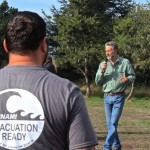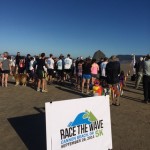EATONTOWN, N.J. — Anyone who owns a business along the New Jersey shore is aware of the role the weather plays in its success or failure. A rainy summer can wreak havoc with the cash register — people don’t come to the beach, visit the boardwalk or stop in at shore restaurants when the weather is bad.
And when a storm like Hurricane Sandy threatens the coastline, owners of coastal businesses batten down the hatches and hope that the preparations they’ve made will keep their property secure.
But there’s a lot more you can do to protect your business than simply covering up windows with plywood and storing outdoor furniture inside.
There are many building and mitigation techniques for coastal properties that make it possible for businesses in vulnerable locations to withstand even a storm as strong as Sandy.
In the wake of that historic hurricane, many owners of hard-hit properties have taken steps to build back stronger. Should the shore be hit by another storm, their businesses will be far more likely to survive with little or no damage.
This has been a quiet year for hurricanes in the mid-Atlantic region, but one thing residents of coastal communities know is that sooner or later, another bad storm will head this way.
Protecting your property means making an investment in your future.
As the stories of these three Jersey Shore businesses illustrate, taking action well before a storm is predicted can make all the difference.
Windansea Restaurant, Highlands, NJ
 Windansea Restaurant Sustained Little Damage from SandyOne month after Superstorm Sandy, Dan Shields and his business partner, Robert Higgins, were thanking their lucky stars. Their waterfront restaurant, Windansea in Highlands, had withstood the raging floods and winds of Superstorm Sandy with relatively minor damage.
Windansea Restaurant Sustained Little Damage from SandyOne month after Superstorm Sandy, Dan Shields and his business partner, Robert Higgins, were thanking their lucky stars. Their waterfront restaurant, Windansea in Highlands, had withstood the raging floods and winds of Superstorm Sandy with relatively minor damage.
The rest of Highlands was not so fortunate. Flood waters inundated dozens of homes and businesses around town. The damage was so extensive that authorities restricted access to the town for several days in order to clear debris and restore public safety. Many of Shields’ and Higgins’ fellow restaurateurs in Highlands were essentially out of business, their kitchens and dining rooms now sodden piles of wreckage.
What saved Windansea?
The partners are quick to credit the borough’s new building code that required properties like their bayside restaurant, which lies in a ‘V’ flood zone, to comply with tough new Federal Emergency Management standards.
When they purchased the property, they’d intended to make only minor renovations, but structural defects required them to replace more than 50 percent of the building, and that meant complying with the new building codes. It was an expensive, time consuming and often frustrating experience, Shields admitted.
But in the end, it saved the restaurant.
Though the building sustained some damage to its first floor lobbies and outdoor Tiki bar, Windansea was back in business less than three weeks after the storm.
Jenkinson’s Aquarium, Point Pleasant, NJ
When Hurricane Sandy hit the Jersey shore in October of 2012, thousands of businesses up and down the coast — from Middlesex County through Cumberland County — were heavily damaged or completely destroyed.
But inside Jenkinson’s Aquarium on the Point Pleasant Boardwalk, all was well with the penguins, sharks and other sea creatures who call the aquarium home.
The popular seaside tourist attraction sustained only minor damage thanks to the efforts of Jenkinson’s staff.
As Hurricane Sandy came ashore, a powerful storm surge swept through the lower floor of Jenkinson’s Aquarium, flowing out into the streets and surged several blocks deep into Point Pleasant Beach, then swept back the way it had come as the surge receded.
Despite the direct hit, the building housing Jenkinson’s Aquarium suffered only minor damage. There was debris to be removed. Several of the aquarium’s large plastic garbage barrels, housed in the lower level when the ocean came through, were scattered around the borough. But the staff embedded in the aquarium remained safe and dry. All of the marine lives – penguins, sharks, seahorses, exotic fish – were safe.
What saved Jenkinson’s?
“Our Business Continuity plan was excellent,” notes Cindy Claus, director of Jenkinson’s Aquarium.
“Without it, I really think we would have been in a bad way. We were ready when Sandy got here.”
See a video about Jenkinson’s Aquarium at: http://www.fema.gov/medialibrary/media_records/11215
Panini Bay, Tuckerton, NJ
When the Panini Bay Waterfront Restaurant in Tuckerton was damaged by Superstorm Sandy, owner and Chef Ivar Johnson had several critical decisions to make. Chief among t The Main Feature of the Rebuilt Panini Bay Is the Enclosed Wheelchair Lifthem was how to maintain wheelchair access for customers with disabilities while elevating the remaining structure and incorporating additional mitigation features.
The Main Feature of the Rebuilt Panini Bay Is the Enclosed Wheelchair Lifthem was how to maintain wheelchair access for customers with disabilities while elevating the remaining structure and incorporating additional mitigation features.
The restaurant had a wheelchair ramp before Sandy, but rebuilding it was not feasible given the height of the elevation.
Panini Bay’s main floor was elevated to sixteen feet above sea level, on 9-foot high pylons. A new seating area was built on a raised platform and the kitchen was relocated to the center of the building. A multilevel staircase was added.
What made elevation workable?
The main feature of the rebuilt Panini Bay is the enclosed wheelchair lift outside the restaurant that transports customers up to the entrance.
The lift cost $25,000. Two people, along with a rider using a wheelchair, can fit inside comfortably. The lift has a seat, a seat belt, and an emergency phone inside. The enclosure cost an additional $12,000 and completely surrounds the lift and its mechanics, but it makes it possible for all of Johnson’s customers to enjoy dinner on the waterfront at Panini Bay.
“The lift gets plenty of use,” Johnson said.
FEMA’s mission is to support our citizens and first responders to ensure that as a nation we work together to build, sustain, and improve our capability to prepare for, protect against, respond to, recover from, and mitigate all hazards.
Follow FEMA online at www.twitter.com/FEMASandy, www.twitter.com/fema, www.facebook.com/FEMASandy, www.facebook.com/fema, www.fema.gov/blog, and www.youtube.com/fema. Also, follow Administrator Craig Fugate’s activities at www.twitter.com/craigatfema.
The social media links provided are for reference only. FEMA does not endorse any non-government websites, companies or applications.”











